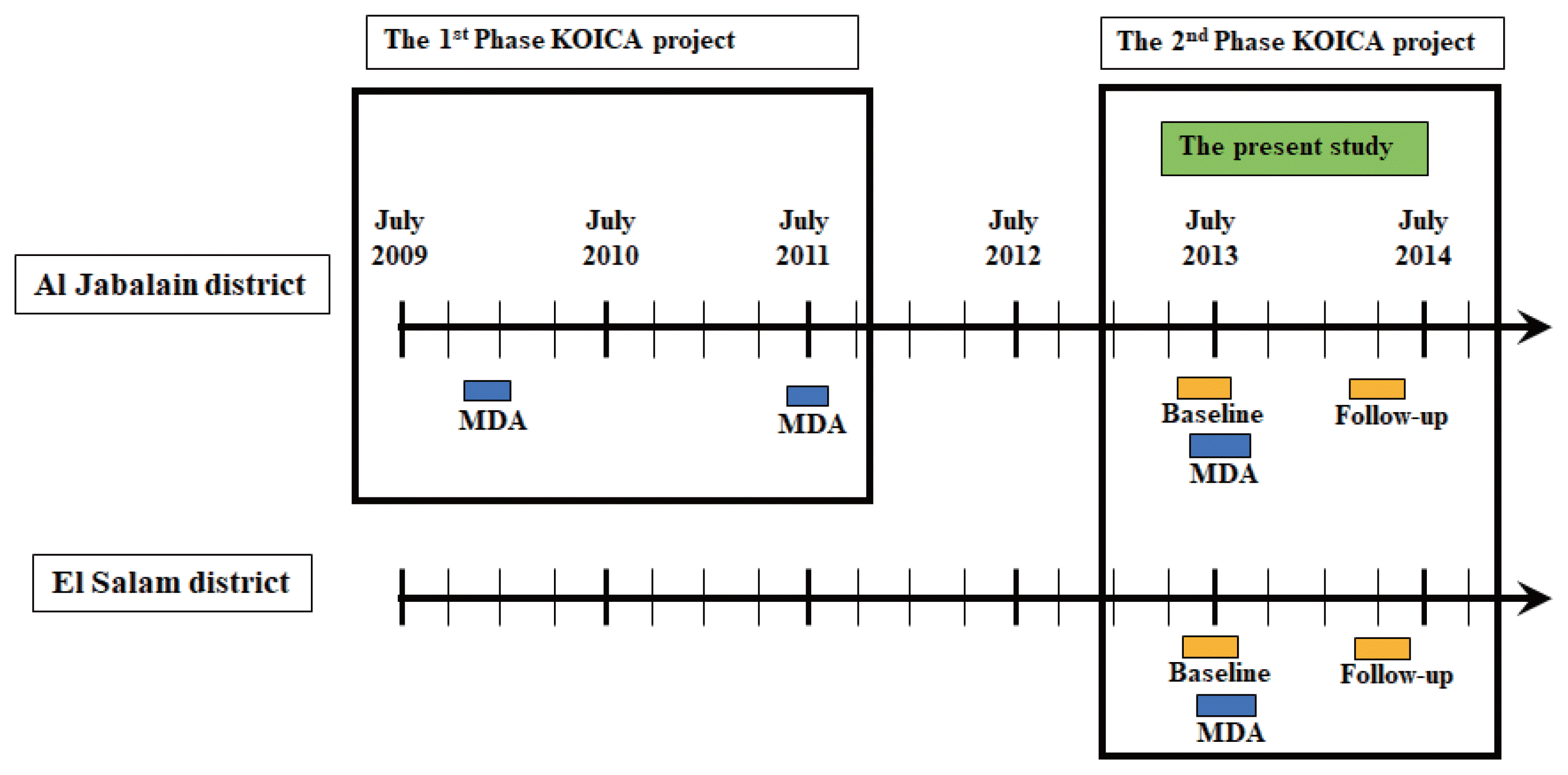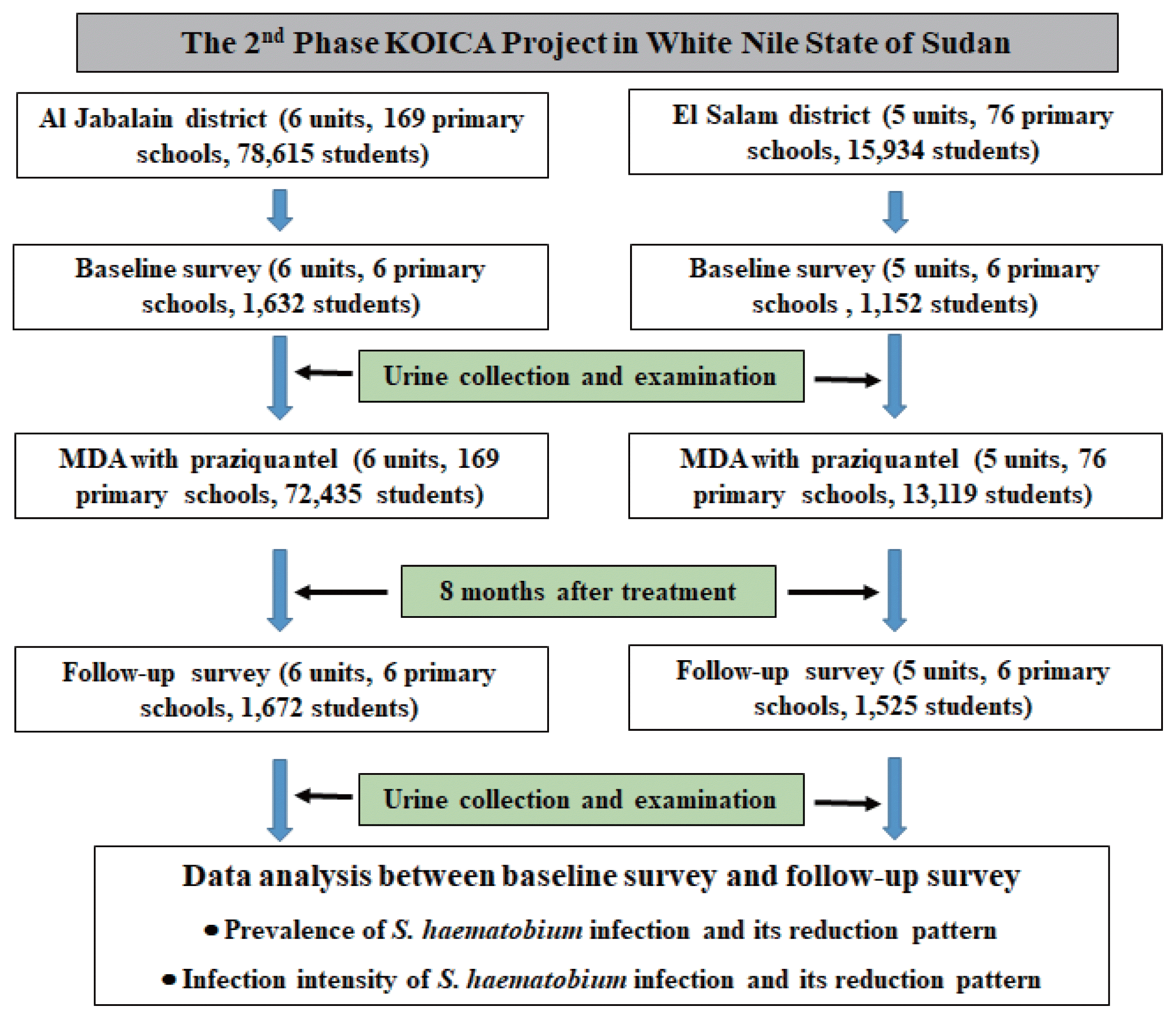1. Gryseels B. Schistosomiasis.
Infect Dis Clin North Am 2012;26:383-397.

2. Hotez PJ, Kamath A. Neglected tropical diseases in sub-Saharan Africa: review of their prevalence, distribution, and disease burden.
PLoS Negl Trop Dis 2009;3:e412.



3. GBD and HALE Collaborators. Global, regional, and national disability-adjusted life-years (DALYs) for 359 diseases and injuries and healthy life expectancy (HALE) for 195 countries and territories, 1990–2017: a systematic analysis for the Global Burden of Disease Study 2017.
Lancet 2018;392:1859-1922.


5. Lee YH, Jeong HG, Kong WH, Lee SH, Cho HI, Nam HS, Ismail HA, Alla GN, Oh CH, Hong ST. Reduction of urogenital schistosomiasis with an integrated control project in Sudan.
PLoS Negl Trop Dis 2015;9:e3423.



6. Ismail HA, Hong ST, Babiker AT, Hassan RM, Sulaiman MA, Jeong HG, Kong WH, Lee SH, Cho HI, Nam HS, Oh Ch, Lee YH. Prevalence, risk factors, and clinical manifestations of schistosomiasis among school children in the White Nile River basin, Sudan.
Parasit Vectors 2014;7:478.



7. Abou-Zeid AH, Abkar TA, Mohamed RO. Schistosomiasis infection among primary school students in a war zone, Southern Kordofan State, Sudan: a cross-sectional study.
BMC Public Health 2013;13:643.



8. Hajissa K, Muhajir AEMA, Eshag HA, Alfadel A, Nahied E, Dahab R, Ali SM, Mohammed M, Gaafar M, Mohamed Z. Prevalence of schistosomiasis and associated risk factors among school children in Um-Asher Area, Khartoum, Sudan. BMC Res Notes 2018;11:779.
9. Cha SM, Elhag MS, Lee YH, Cho DS, Ismail HA, Hong ST. Epidemiological findings and policy implications from the nationwide schistosomiasis and intestinal helminthiasis survey in Sudan.
Parasit Vectors 2019;12:429.



10. Zhang Y, MacArthur C, Mubila L, Baker S. Control of neglected tropical diseases needs a long-term commitment.
BMC Med 2010;8:67.



11. World Health Organization. Helminth Control in School Age Children: A Guide for Managers of Control Programmes. 2nd ed. Geneva, Switzerland. World Health Organization. 2011.
12. Atalabi TE, Adubi TO. The epidemiology and chemotherapeutic approaches to the control of urinary schistosomiasis in school-age children (SAC): a systematic review.
BMC Infect Dis 2019;19:73.



13. Atalabi TE, Adoh SD, Eze KM. The current epidemiological status of urogenital schistosomiasis among primary school pupils in Katsina State, Nigeria: An imperative for a scale up of water and sanitation initiative and mass administration of medicines with Praziquantel.
PLoS Negl Trop Dis 2018;12:e0006636.

14. Ahmed AM, Abbas H, Mansour FA, Gasim GI, Adam I.
Schistosoma haematobium infections among school children in central Sudan one year after treatment with praziquantel.
Parasit Vectors 2012;5:108.



15. Touré S, Zhang Y, Bosqué-Oliva E, Ky C, Ouedraogo A, Koukounari A, Gabrielli AF, Bertrand S, Webster JP, Fenwick A. Two-year impact of single praziquantel treatment on infection in the national control programme on schistosomiasis in Burkina Faso.
Bull World Health Organ 2008;86:780-787.

16. King CH, Kittur N, Binder S, Campbell CH, N’Goran EK, Meite A, Utzinger J, Olsen A, Magnussen P, Kinung’hi S, Fenwick A, Phillips AE, Gazzinelli-Guimaraes PH, Dhanani N, Ferro J, Karanja DMS, Mwinzi PNM, Montgomery SP, Wiegand RE, Secor WE, Hamidou AA, Garba A, Colley DG. Impact of different mass drug administration strategies for gaining and sustaining control of
Schistosoma mansoni and
Schistosoma haematobium infection in Africa.
Am J Trop Med Hyg 2020;103(suppl):14-23.



17. Dejon-Agobé JC, Edoa JR, Honkpehedji YJ, Zinsou JF, Adégbitè BR, Ngwese MM, Mangaboula A, Lell B, Grobusch MP, Mordmüller B, Adegnika AA.
Schistosoma haematobium infection morbidity, praziquantel effectiveness and reinfection rate among children and young adults in Gabon.
Parasit Vectors 2019;12:577.



18. Hayes RJ, Bennett S. Simple sample size calculation for cluster-randomized trials.
Int J Epidemiol 1999;28:319-326.


19. World Health Organization. Prevention and Control of Schistosomiasis and Soil-Transmitted Helminthiaisis: WHO Tech Report Series No. 912. Geneva, Switzeland. World Health Organization. 2002.
20. World Health Organization. Basic laboratory methods in Medical Parasitology. Geneva, Switzeland. World Health Organization. 1991, pp 33-35.
21. Ahmed ES, Daffalla A, Christensen NO, Madsen H. Patterns of infection and transmission of human schistosomiasis mansoni and schistosomiasis haematobium in White Nile Province, Sudan.
Ann Trop Med Parasitol 1996;90:173-180.


22. Lee YH, Lee JS, Jeoung HG, Kwon IS, Mohamed AAWS, Hong ST. Epidemiological survey on schistosomiasis and intestinal helminthiasis among village residents of the rural river basin area in White Nile State, Sudan.
Korean J Parasitol 2019;57:135-144.



23. Andrade G, Bertsch DJ, Gazzinelli A, King CH. Decline in infection-related morbidities following drug-mediated reductions in the intensity of
Schistosoma infection: a systematic review and meta-analysis.
PLoS Negl Trop Dis 2017;11:e0005372.



24. Kim MJ, Ryu K, Jin Y, Lee YH, Jeoung HG, Saeed AA, Kim SH, Hong ST. Significance of echogenic snow sign as an ultrasonography finding for diagnosis of urogenital schistosomiasis.
Am J Trop Med Hyg 2016;95:842-848.



25. Zwang J, Olliaro P. Efficacy and safety of praziquantel 40 mg/kg in preschool-aged and school-aged children: a meta-analysis.
Parasit Vectors 2017;10:47.






